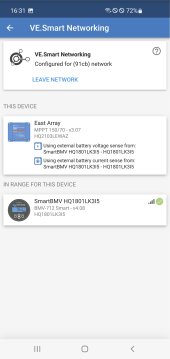Ok guys, I finally assembled my cells into a battery, equipped it with an Overkill BMS, Victron BMV-712 Smart Shunt and a Victron MPPT 100/30 charge controller and a Victron Blue Smart IP22 AC/DC charger.
In the testing phase and things going very well. Have the BMS configured how I want and the Bluetooth Ap running on my Android phone just fine.
Created a Victron network on the Victron Connect AP and have all three Victron components on line in the same phone thru that AP. Went thru the settings and feel confident I have the parameters set well to match my 280Ah battery and Overkill BMS, at least as a good starting point.
Here is the question I have and there was one just a couple weeks ago that was similar. I don't quite understand "Tail Current" its purpose and how I should set that parameter. All Victron has to say about it is: "Once the charge current has dropped to less than the set tail current (% of battery capacity) the battery is considered fully charged." Also: " Some chargers stop charging when the current drops below a set threshold. The tail current must be set higher than this threshold."
First off, according the IP22 Charger manual the charger never really shuts down or stops charging it goes into Absorption (14.2v) and then Float (`13.5v) in the LifePO4 mode.
What should I do with this Tail Current setting in the Smart Shunt? I don't even understand the purpose of it let alone know what to set it at. The default is set at 4% which is 11.2 amps. So in this case once the charging current goes below 11.2A there will be no more charging take place? Do I understand that correctly from the statement above which was taken directly from the Smart Shunt manual?
Do I set this parameter to something very low like .02% (.002 X 280 = .58A???)
I really don't know what to do with this setting and the Victron manual gives very little guidance or education about it. HELP.
In the testing phase and things going very well. Have the BMS configured how I want and the Bluetooth Ap running on my Android phone just fine.
Created a Victron network on the Victron Connect AP and have all three Victron components on line in the same phone thru that AP. Went thru the settings and feel confident I have the parameters set well to match my 280Ah battery and Overkill BMS, at least as a good starting point.
Here is the question I have and there was one just a couple weeks ago that was similar. I don't quite understand "Tail Current" its purpose and how I should set that parameter. All Victron has to say about it is: "Once the charge current has dropped to less than the set tail current (% of battery capacity) the battery is considered fully charged." Also: " Some chargers stop charging when the current drops below a set threshold. The tail current must be set higher than this threshold."
First off, according the IP22 Charger manual the charger never really shuts down or stops charging it goes into Absorption (14.2v) and then Float (`13.5v) in the LifePO4 mode.
What should I do with this Tail Current setting in the Smart Shunt? I don't even understand the purpose of it let alone know what to set it at. The default is set at 4% which is 11.2 amps. So in this case once the charging current goes below 11.2A there will be no more charging take place? Do I understand that correctly from the statement above which was taken directly from the Smart Shunt manual?
Do I set this parameter to something very low like .02% (.002 X 280 = .58A???)
I really don't know what to do with this setting and the Victron manual gives very little guidance or education about it. HELP.




